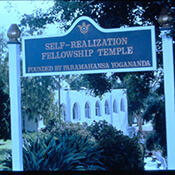 Paramahansa Yogananda was a Hindu teacher who came to America to attend the International Congress of Religious Liberals in Boston in 1920, and stayed to found a religious movement. Yogananda promoted yoga as an intersection of science and religion that emphasized the mind-body relationship. Yogananda wrote The Autobiography of a Yogi, which was published in 1946; at the time of his passing in 1952, his organization the Self-Realizaiton Fellowship was the most prominent Hindu organization in the United States.
Paramahansa Yogananda was a Hindu teacher who came to America to attend the International Congress of Religious Liberals in Boston in 1920, and stayed to found a religious movement. Yogananda promoted yoga as an intersection of science and religion that emphasized the mind-body relationship. Yogananda wrote The Autobiography of a Yogi, which was published in 1946; at the time of his passing in 1952, his organization the Self-Realizaiton Fellowship was the most prominent Hindu organization in the United States.
Paramahansa Yogananda was another Hindu teacher who came to America for a conference and stayed to found a religious movement. The title Paramahansa, “The Great Wild Swan,” was bestowed by his teacher in India, Swami Yukteswar. The wild swan is the symbol of the liberated soul, and it is the title given to those rare teachers who have achieved this state of freedom. Yogananda was from Bengal and came to the United States to attend a meeting of the International Congress of Religious Liberals held in Boston in 1920. After the conference, Yogananda, like Vivekananda, stayed in the United States, launching the Self-Realization Fellowship (SRF) in 1925. While Vivekananda returned to India after a few years, Yogananda spent the rest of his life in the United States, returning to India only to visit.
Yogananda used the language of science to teach yoga and saw the Self-Realization Fellowship as uniting science and religion through realization of the unity of their underlying principles. Yogananda was among the first to emphasize the “mind-body” relation, especially for health and healing. Decades later, the yogic knowledge that the focus of the mind can alter the state of the body would become a presupposition of the “new age” and of new perspectives in medicine. Yogananda’s teachings foreshadowed this development. His short collection of “Scientific Healing Affirmations” stresses the role of mental affirmation in the healing of the body.
Yogananda made Los Angeles the center of the Self-Realization Fellowship. He had a knack for organizing and promoting yoga and “self-realization” through dozens of local centers and through a correspondence course available to those who did not live near a center. The popularity of the movement and of Yogananda was enhanced with the publication of his book, The Autobiography of a Yogi (l946). At the time of Yogananda’s death in 1952, the SRF was the most important and extensive Hindu organization in the United States.